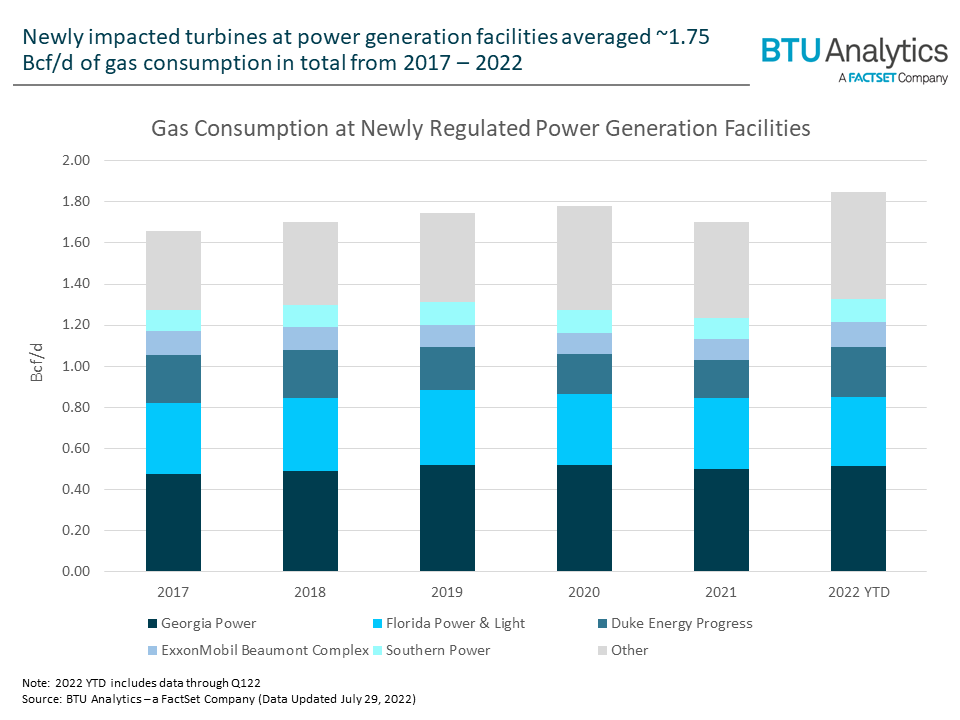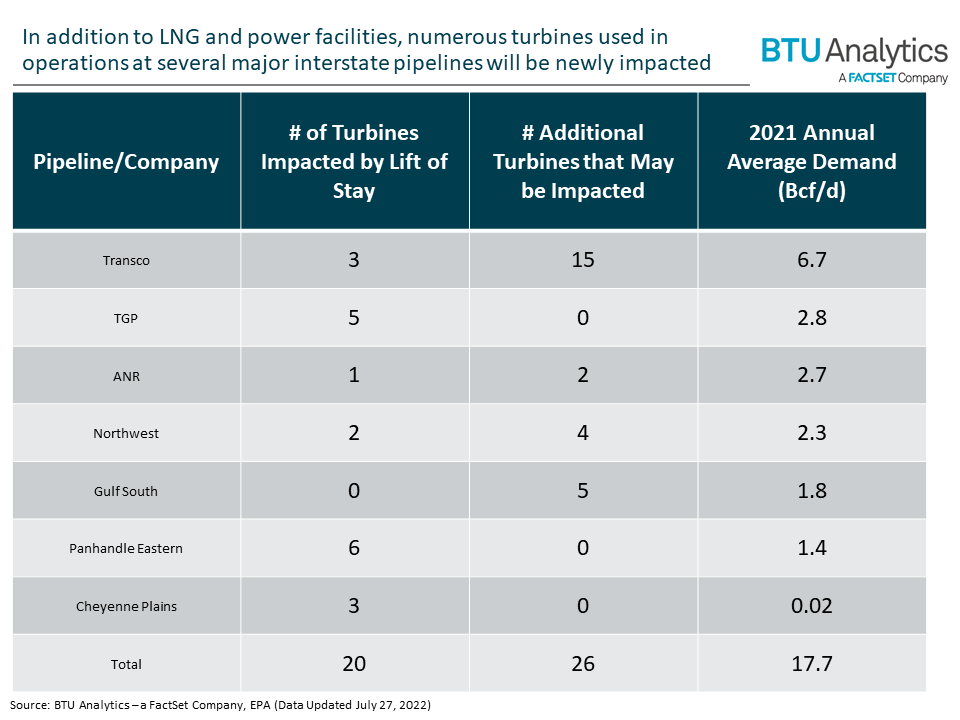In February 2022, the US Environmental Protection Agency (EPA) announced a change to its regulatory regime for gas-fired turbines under the National Emission Standards for Hazardous Air Pollutants (NESHAP) – a framework in place since 2004. At first glance, this announcement would seem to be a minor update to a highly technical rule, but a careful examination of the list of impacted units reveals that the change in enforcement framework could have significant impacts to both supply and demand dynamics in natural gas markets in the US and beyond, affecting LNG exports, gas-fired power generation, and gas transmission and processing infrastructure in particular. Today’s Energy Market Insight will examine each of these potential areas of impact individually and assess the overall risk that the changes to NESHAP enforcement present to natural gas markets and operational infrastructure.
Specifically, the EPA announced that the agency would be removing an 18-year stay in its enforcement of the rule’s formaldehyde standards for two subclasses of turbines and will now be requiring all units to demonstrate compliance with the full rule by September 5, 2022 (180 days after the March 9 official compliance date imposed in the update). While the precise number of additional turbines that will now be required to demonstrate compliance with the formaldehyde standards is not known, EPA estimates the number at approximately 250 with more than 230 units positively identified as newly impacted.
The most immediately striking aspect of the list of newly impacted units is the inclusion of a large number of turbines involved in the production of LNG for export at three large Gulf Coast facilities: Cheniere Energy’s Sabine Pass and Corpus Christi facilities and Sempra Energy’s Cameron LNG. With global demand for LNG at an all-time high, natural gas flows to these facilities have totaled between 8 and 9 Bcf/d in every month in 2022 and each facility has continuously run at or near capacity.

In total, EPA documentation indicates that the rule change impacts a total of 44 turbines at Sabine Pass, 18 at Corpus Christi, and 10 at Cameron. In all cases, the impacted turbines are apparently involved directly in refrigerant compression operations. Also, according to recent media reports, Cheniere has petitioned the Biden Administration for an exemption to the reinstated formaldehyde standards, maintaining that coming into compliance would entail a major engineering effort and halt or reduce operations for an extended period of time. If any or all of these facilities are required to drastically reduce operations to come into compliance with the revised NESHAP standards, the results would be significant to markets in the US and beyond. In the weeks following the June 2022 explosion at the Freeport LNG facility, Henry Hub pricing fell more than $2/MMBtu. While there were likely a number of factors contributing to this decline, it is clear that the removal of Freeport’s ~1.8 Bcf/d of gas demand exerted significant downward pressure on pricing. With daily gas demand at both Cameron and Corpus Christi sized similarly to Freeport, and Sabine Pass demand roughly twice that of Freeport, the market shock of extended shutdowns at any of these plants, individually or collectively, would likely be at least as large as that observed in the aftermath of the Freeport explosion. In addition, further disruptions to LNG exports would exert even more upward pressure on global LNG prices as natural gas futures in Europe near $60/MMBtu for Winter ‘22/’23.
While disruptions at large LNG facilities remain the largest risk factor for demand destruction, there are also a number of relatively large units at utilities and industrial facilities that will be impacted by the rule change.

Since 2017, the power units in the graphic above have collectively averaged ~1.75 Bcf/d of gas demand, which are volumes that may be at risk if some or all of these units are required to reduce operations to make modifications to come into compliance with the reinstated formaldehyde standard. It is also worth noting that more than 1 Bcf/d of this additional demand is related to utility power production in the Southeast US, including units at Georgia Power, Florida Power & Light, and Southern Power. BTU Analytics currently estimates that total power demand in the Southeast will average ~8 Bcf/d in 2022. Thus, these volumes represent a significant total of overall regional gas generation. It is also worth noting that turbines at ExxonMobil’s 366 Mb/d Beaumont refinery are impacted by the rule change as well.
Finally, while harder to quantify than the demand destruction risks, the NESHAP rule revisions have the potential to impact natural gas supply as well. Several key compressors on many major interstate pipelines and some large gas processing facilities are also potentially impacted.

In the case of the pipeline turbines, which are mostly used in compressor station operations, the eligibility of many turbines has still not been determined by the EPA. For instance, Transco has 15 units that may or may not be impacted. However, all of the pipelines listed in the graphic above are critical arteries connecting supply and demand in the US. In 2021, these seven pipelines served 17.7 Bcf/d of demand. In addition to the interstate pipelines listed above, 23 turbines at Williams’ Opal and Echo Springs gas plants, and four turbines on the intrastate Oasis Pipeline (connecting Waha to Katy) may be impacted under the new rule. While the total gas burn at these turbines is likely not material in terms of overall gas demand, any outages related to bringing these units into compliance could potentially impact natural gas pricing through flow disruptions.
As outlined above, the rule change brings with it potential disruptions to both natural gas supply and demand. However, it seems unlikely that there will be a severe impact immediately after the September 5 compliance date for a several reasons. First, the language of the final rule leaves the EPA with a large amount of discretion with regard to enforcement, stating, “For a source that fails to comply with the applicable requirements…the EPA will determine an appropriate response, if any, based on, among other things, the good faith effort of the source to comply.” It is entirely possible that the penalties for inaction will be minor and/or that the EPA will continue to work with operators to bring impacted units into compliance via a longer time frame that minimizes disruptions. Second, it is possible that some of the impacted units have either already been brought into compliance or were built in compliance since there has been no enforcement or testing over the last 18 years. Also, it is possible that some units could be brought into compliance without a major engineering effort. Finally, it seems likely that the Biden administration will take action to avoid disruptions, particularly to LNG assets, due to geopolitical tensions and the resulting initiatives required to provide energy security to European allies. In short, while these new changes to the NESHAP have the potential to impact many key components of US and global natural gas markets, there are both mechanisms and strong incentives in place to mitigate the most disruptive outcomes.









